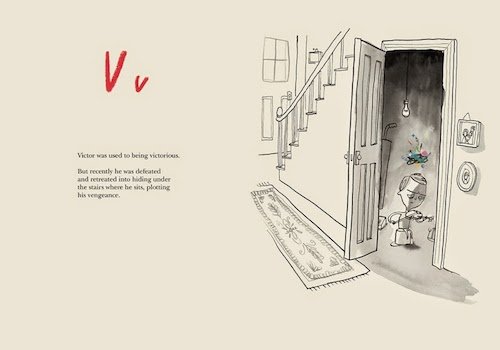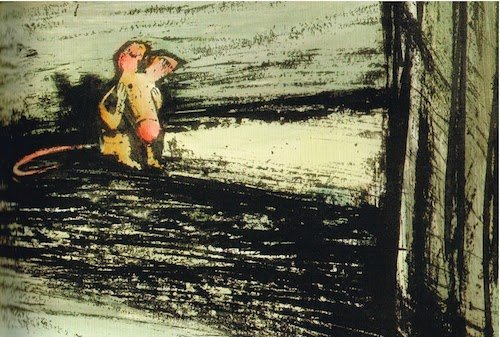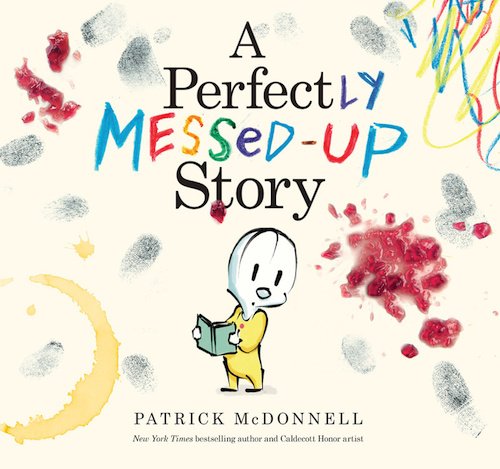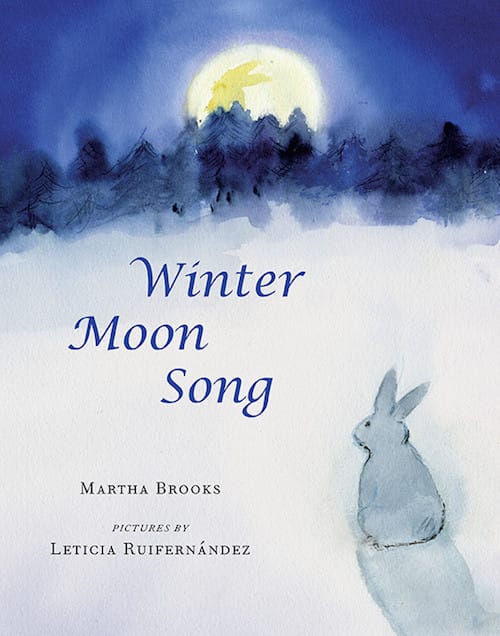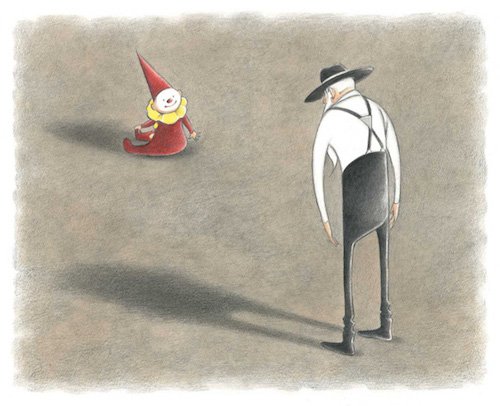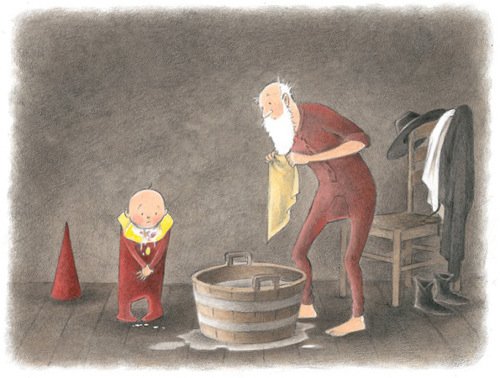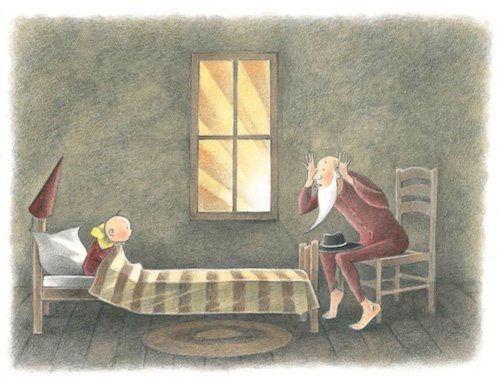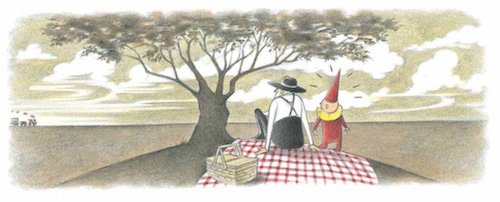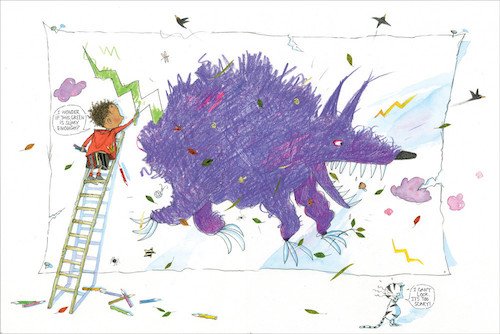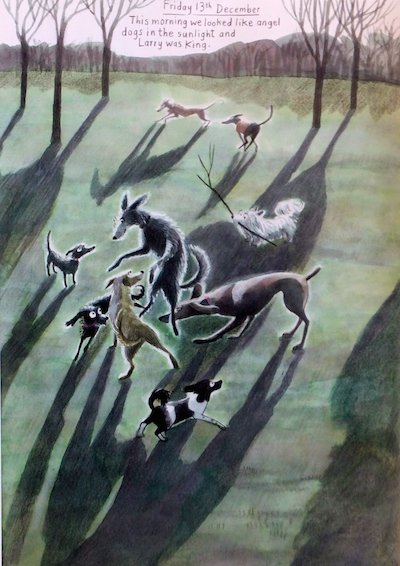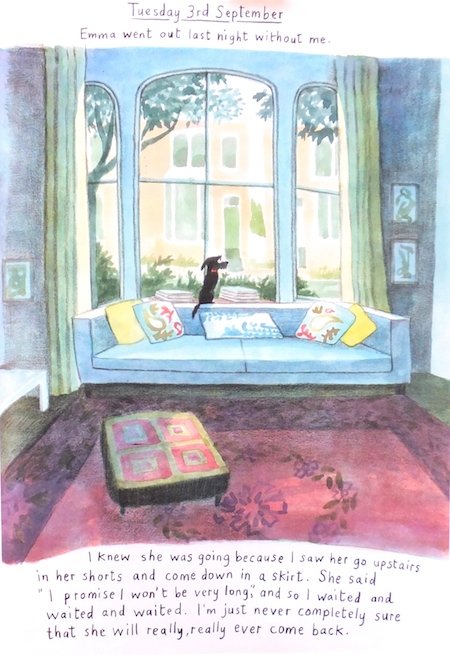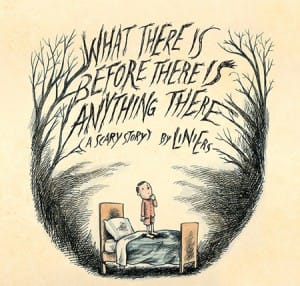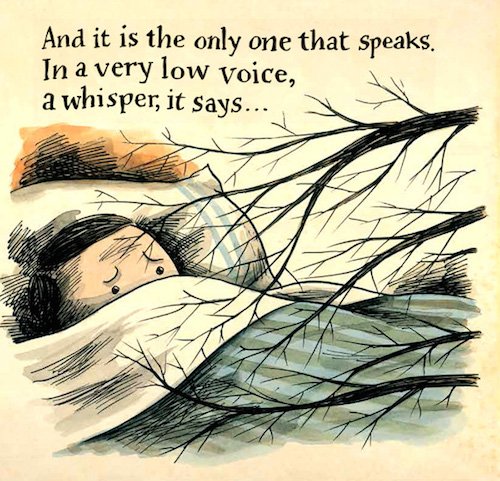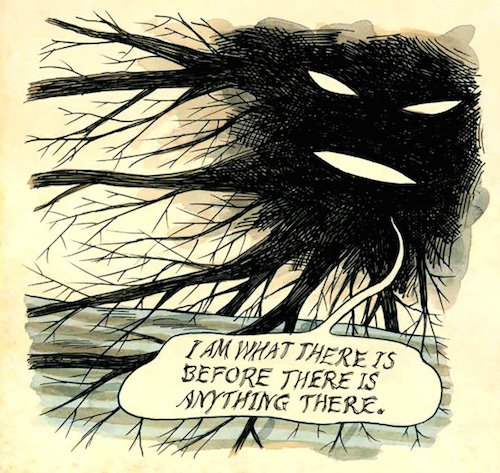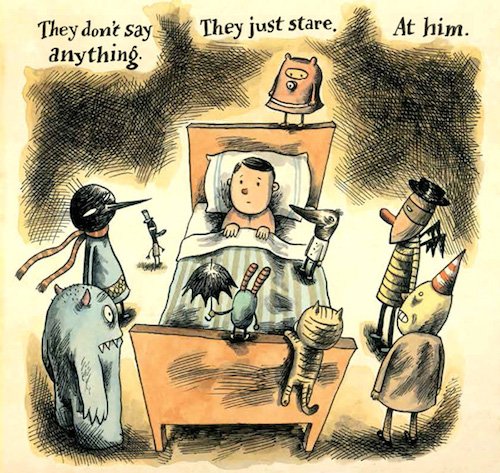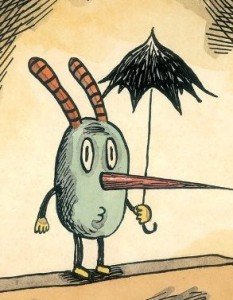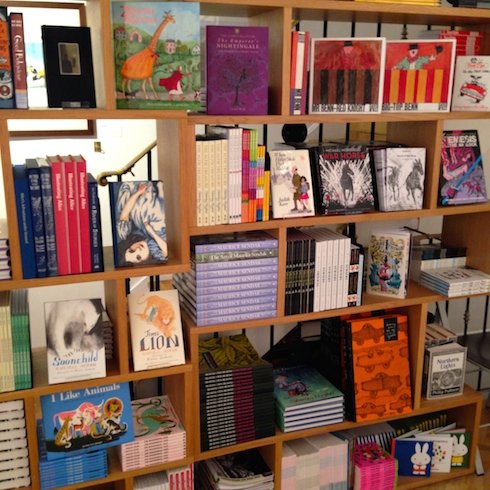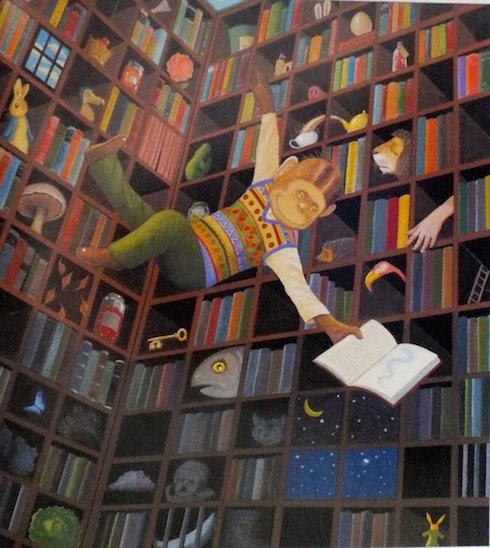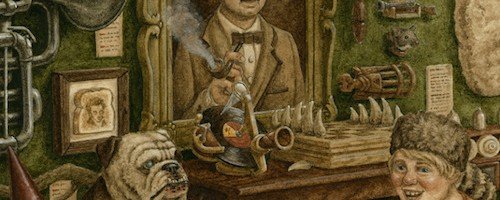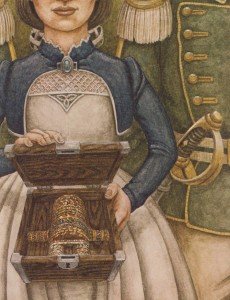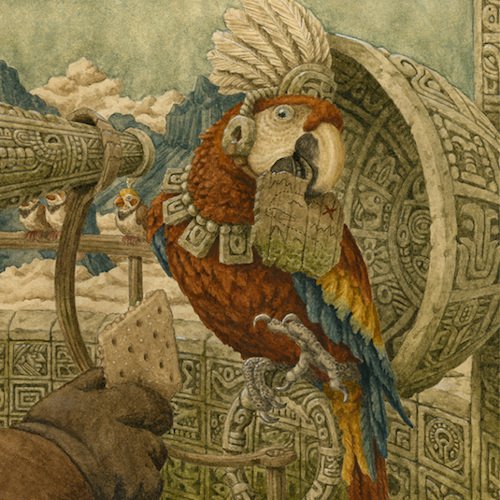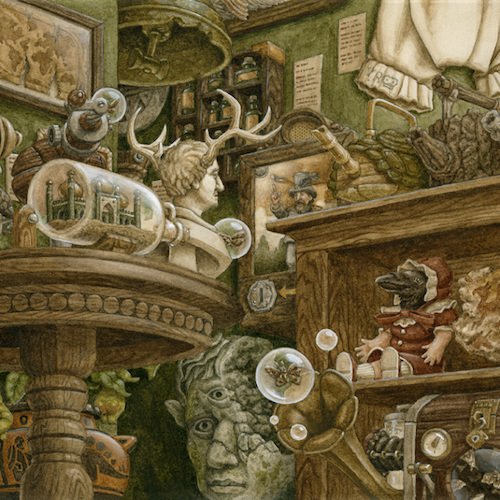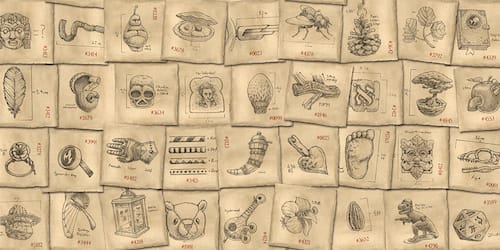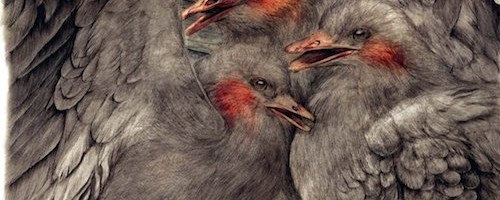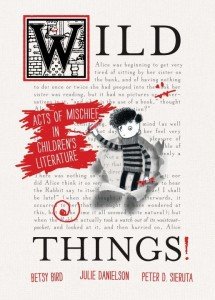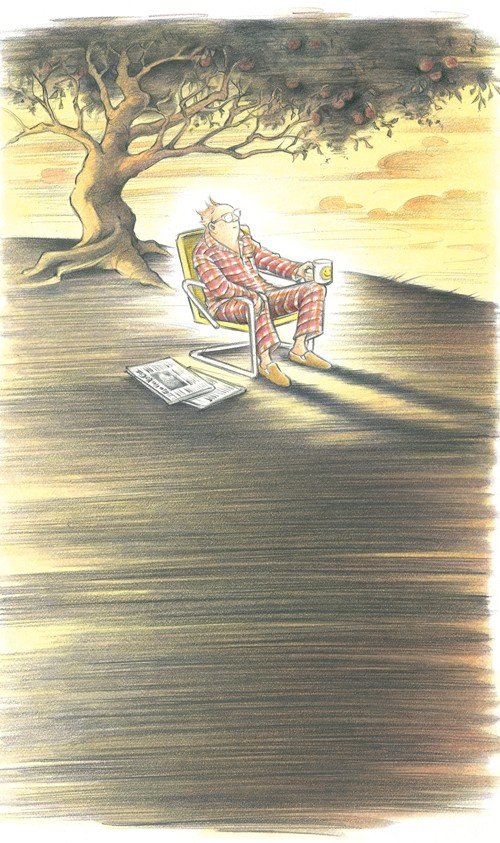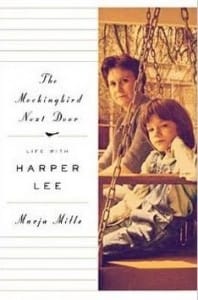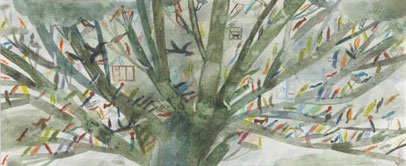And I mean that! As in previous years, I am at the end of 2014 without getting to the end of the to-be-reviewed books on my desk. Absolutely nothing to do with how I feel about these lovelies – I just ran out of time! Rather than carry them forward into the murky future, I would prefer to say a few words now, lest they be inexcusably ignored in favour of some pretty new thing in 2015. You know how that happens. Anyway, no order to this list, just deep appreciation and love. Longer reviews may follow…
Once Upon an Alphabet-Oliver Jeffers (HarperCollins, 2014) This book has been on many ‘best of’ lists this year for all the usual Jeffersonian superlatives: it’s beautiful, funny, and deeply endearing. Also stupidly, ridiculously, unbelievably brilliant. Each letter of the alphabet is given its own short story. My favourite is ‘W’ for the Whiraffe: “The ingenious inventor had a favourite invention of all-the Whiraffe. It had the head of a whisk and the body of a giraffe. They became great friends over the years and enjoyed strawberries and whipped cream. The Whiraffe, of course, whipped the cream.” All the stories are wonderful and the art is inexplicably retro and original. It would be my favourite picture book of the year, except that The Farmer and the Clown hit me in the feels in a way that no other book did in 2014.
 Sam & Dave Dig a Hole-Mac Barnett, illustrations by Jon Klassen (Candlewick Press, 2014) Individually and collaboratively, these guys are redefining the children’s picture book genre in ways that haven’t been seen since Jon Scieszka and Lane Smith gave us The Stinky Cheese Man. Seriously, who writes a book about digging a hole? Don’t be fooled. Shoveling dirt may seem mundane, but Barnett and Klassen elevate the subject matter way beyond its assumed possibilities, turning Sam & Dave Dig a Hole into a great, boyish adventure with a delicious twist of wry, mind-bending humour. It also says something about the human condition: always striving, never quite achieving, up for anything.
Sam & Dave Dig a Hole-Mac Barnett, illustrations by Jon Klassen (Candlewick Press, 2014) Individually and collaboratively, these guys are redefining the children’s picture book genre in ways that haven’t been seen since Jon Scieszka and Lane Smith gave us The Stinky Cheese Man. Seriously, who writes a book about digging a hole? Don’t be fooled. Shoveling dirt may seem mundane, but Barnett and Klassen elevate the subject matter way beyond its assumed possibilities, turning Sam & Dave Dig a Hole into a great, boyish adventure with a delicious twist of wry, mind-bending humour. It also says something about the human condition: always striving, never quite achieving, up for anything.
Gustave-Rémy Simard, illustrations by Pierre Pratt (Groundwood Books, 2014) If you like odd, existential tales, steeped in grief, with a tinge of dark humour – or  if you’re Russian, Gustave is the book for you. It begins with this: “He’s gone,” followed by a heart-wrenching illustration of a little mouse in tormented grief after Gustave, his brother, is killed by a cat. Gustave has sacrificed himself to save his brother, leaving his sibling with a whopping case of survivor’s guilt. The little mouse wanders the unfriendly streets fretting about what to tell his mother. To say the story ends in an unusual way would not be understating it; putting the
if you’re Russian, Gustave is the book for you. It begins with this: “He’s gone,” followed by a heart-wrenching illustration of a little mouse in tormented grief after Gustave, his brother, is killed by a cat. Gustave has sacrificed himself to save his brother, leaving his sibling with a whopping case of survivor’s guilt. The little mouse wanders the unfriendly streets fretting about what to tell his mother. To say the story ends in an unusual way would not be understating it; putting the 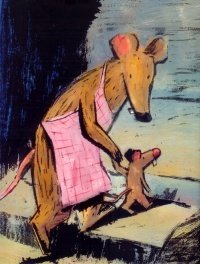 book in a different, decidedly comical light. Gustave is not about grief per se – it is entirely (and wonderfully) its own unique thing. I kinda love it. I love its courage and its strangeness. The illustrations by three-time Governor-General’s Award recipient Pierre Pratt are both beautiful and suitably tortured. Colours appear scraped and textured, dimly lit, brooding. The mice, however, are full of character and charm. Gustave is not for everyone, but I promise, it will be an experience.
book in a different, decidedly comical light. Gustave is not about grief per se – it is entirely (and wonderfully) its own unique thing. I kinda love it. I love its courage and its strangeness. The illustrations by three-time Governor-General’s Award recipient Pierre Pratt are both beautiful and suitably tortured. Colours appear scraped and textured, dimly lit, brooding. The mice, however, are full of character and charm. Gustave is not for everyone, but I promise, it will be an experience.
 The Mutts Diaries-Patrick McDonnell (Andrews McMeel, 2014) As the title suggests, this book is a collection of Mutts cartoons organized by character into diary entries. A great introduction for those who are new to this magnificent cartoon created by Patrick McDonnell. It is also perfect for the devotees (such as myself) who have favourite characters and wish to read their stories in concentrated form – in particular Guard Dog, the perpetually chained bulldog who is loveable and kind in spite of his cruel restraints. An excellent companion to the annual treasuries (for 2014: Living the Dream) and all the other Mutts related publications.
The Mutts Diaries-Patrick McDonnell (Andrews McMeel, 2014) As the title suggests, this book is a collection of Mutts cartoons organized by character into diary entries. A great introduction for those who are new to this magnificent cartoon created by Patrick McDonnell. It is also perfect for the devotees (such as myself) who have favourite characters and wish to read their stories in concentrated form – in particular Guard Dog, the perpetually chained bulldog who is loveable and kind in spite of his cruel restraints. An excellent companion to the annual treasuries (for 2014: Living the Dream) and all the other Mutts related publications.
A Perfectly Messed-Up Story-Patrick McDonnell (Little, Brown & Company, 2014) An unusual publication from my very favourite person Patrick McDonnell in that it does not contain any of his Mutts characters. It is a stand-alone picture book about rejecting perfectionism in favour of embracing life’s inevitable messiness. Literally, that is; the book is covered in jam and peanut butter stains, much to the frustration of the main character Louis, who is merely trying to tell his story. I’m not so sure I’d be happy about someone messing up my books either, but the point is well-taken. The book reminds me of the Daffy Duck cartoon where the cartoonist intrudes on Daffy’s personal space. A Perfectly Messed-Up Story, like all of McDonnell’s stories, is deceptively simple, subversively Zen, and full of charm (and a bit of strawberry jam).
 Kuma-Kuma Chan, The Little Bear-Kazue Takahashi (Museyon, 2014) Originally published in 2001 in Japan, Kuma-Kuma Chan, The Little Bear is newly translated into English, and it is surely one of the sweetest, most endearing books I’ve read this year. A tiny book about a tiny, puff-ball bear living in the mountains, Kuma-Kuma Chan is charm personified. An unseen narrator wonders what Kuma-Kuma Chan does all day, and so page by page we learn the habits of the inventively self-entertaining bear: what he eats, how he plays, and all the other simple rituals of home life. Some activities are a little quirky; for instance, lining up the trimmings from his nails and gazing at them. Other pursuits speak to Kuma-Kuma Chan’s appreciation of the simple pleasures of a solitary life, like listening to the rain, or taking naps. The illustrations are soft and childlike, beautifully mirroring the quiet, meditative tone of the book. With shelves of loud, intentionally ironic children’s books trying mightily to attain cross-generational appeal, it’s wonderful to read a book that is genuinely sweet and gentle – aimed specifically at young children. It’s easy to see why this book is so popular in Japan. Hopefully Kuma-Kuma Chan, The Little Bear will spark interest here in North America.
Kuma-Kuma Chan, The Little Bear-Kazue Takahashi (Museyon, 2014) Originally published in 2001 in Japan, Kuma-Kuma Chan, The Little Bear is newly translated into English, and it is surely one of the sweetest, most endearing books I’ve read this year. A tiny book about a tiny, puff-ball bear living in the mountains, Kuma-Kuma Chan is charm personified. An unseen narrator wonders what Kuma-Kuma Chan does all day, and so page by page we learn the habits of the inventively self-entertaining bear: what he eats, how he plays, and all the other simple rituals of home life. Some activities are a little quirky; for instance, lining up the trimmings from his nails and gazing at them. Other pursuits speak to Kuma-Kuma Chan’s appreciation of the simple pleasures of a solitary life, like listening to the rain, or taking naps. The illustrations are soft and childlike, beautifully mirroring the quiet, meditative tone of the book. With shelves of loud, intentionally ironic children’s books trying mightily to attain cross-generational appeal, it’s wonderful to read a book that is genuinely sweet and gentle – aimed specifically at young children. It’s easy to see why this book is so popular in Japan. Hopefully Kuma-Kuma Chan, The Little Bear will spark interest here in North America.
Winter Moon Song-Martha Brooks, illustrations by Leticia Ruifernández (Groundwood Books, 2014) I’ve not read many folktales about rabbits. Certainly, rabbits figure prominently in children’s literature (and my backyard), but they tend toward the fuzzy side of things, less on the mythological. (The long ears lack gravitas, I guess.) In the lovely Winter Moon Song, Martha Brooks gives us an ethereal rabbit story that reads like an old folktale and is, in fact, distilled from various legends about mother rabbit and the rabbit moon. Rabbit moon? Yes, I suppose shadows falling across the face of the moon do, at times, resemble a rabbit, especially when brought to life by Spanish illustrator Leticia Ruifernández. Wishing to honour his ancestral past in a meaningful way, a young rabbit, ‘not so small as to be a still-doted-upon baby, yet not so big enough to be noticed’, sings the traditional Winter Moon Song on a violet-infused winter night ‘to lighten the darkest month of the year with a trail of magic.’ Winter Moon Song is a story simply, and exquisitely told.
 Cats are Cats-Valeri Gorbachev (Holiday House, 2014) For all those who appreciate cats, of all stripes. Miss Bell brings home a kitty from a pet store, and discovers, rather late, that the cat is in fact, a tiger. She loves him anyway, even as he lays waste to her home. Frankly, an actual kitty will lay waste to your home. When it comes to cats, size does NOT matter. Miss Bell buys some fish for her cat, not as food, but as companions. One of the fish…well, as Miss Bell says, fish are fish (even when they’re sharks). The illustrations by Ukraine emigre Valeri Gorbachev are sweet and funny. This is one tiger I would definitely invite over for tea.
Cats are Cats-Valeri Gorbachev (Holiday House, 2014) For all those who appreciate cats, of all stripes. Miss Bell brings home a kitty from a pet store, and discovers, rather late, that the cat is in fact, a tiger. She loves him anyway, even as he lays waste to her home. Frankly, an actual kitty will lay waste to your home. When it comes to cats, size does NOT matter. Miss Bell buys some fish for her cat, not as food, but as companions. One of the fish…well, as Miss Bell says, fish are fish (even when they’re sharks). The illustrations by Ukraine emigre Valeri Gorbachev are sweet and funny. This is one tiger I would definitely invite over for tea.
Mr Chicken Lands On London-Leigh Hobbs (Allen & Unwin, 2014) In September, I visited London, England – very briefly, to see Kate Bush perform and visit a few galleries. After many hours on planes, trains (but no automobiles), I wearily found my hotel in the centre of Hammersmith, and  much to my surprise…shock, actually, I was presented with a package at the front desk. What it could be, or for that matter, who knew I was even in London, in that hotel? When I ripped open the package, it was a book – Mr Chicken Lands on London from my blogger friend Zoe at the brilliant Playing By the Book. How wonderful is that??? Though my touristy adventures in London over the next few days mirrored those of Mr Chicken, I do hope I was not as conspicuous as monsieur poulet, although I did spend an awful lot of time staring at oversized maps. It’s a terribly funny book, with lively, quirky art. Thanks again to Zoe for welcoming me to London in such brilliant fashion!
much to my surprise…shock, actually, I was presented with a package at the front desk. What it could be, or for that matter, who knew I was even in London, in that hotel? When I ripped open the package, it was a book – Mr Chicken Lands on London from my blogger friend Zoe at the brilliant Playing By the Book. How wonderful is that??? Though my touristy adventures in London over the next few days mirrored those of Mr Chicken, I do hope I was not as conspicuous as monsieur poulet, although I did spend an awful lot of time staring at oversized maps. It’s a terribly funny book, with lively, quirky art. Thanks again to Zoe for welcoming me to London in such brilliant fashion!
That’s it. Apologies to any books that have found their ways into the nooks and crannies of my bookshelves, too shy to be reviewed. I’ll find you, and I’ll be gentle. Until then, Merry Christmas (yes, I posted this hours before the blessed event), and my deepest, deepest, gratitude to the illustrators, authors, fellow bloggers, and readers who have made the 2014 reading year so grand. THANK YOU! XXOO

